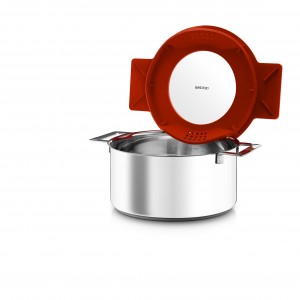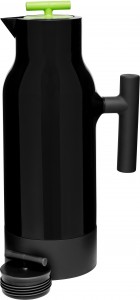Appeal to the Design Conscious Customer with Details and Background
By Amber Gallegos
For some customers a can opener that functions is the best option, for design conscious customers it must function and have great form. While not every customer is going to have such a mindset, having knowledge readily available to assist them is the best tool in your arsenal for selling to the design conscious.
The design-conscious customer is most likely seeking kitchenware pieces that reflect a personal aesthetic they carry with them throughout all aspects of their life. For this customer, great design adds to the value of the product.
“It’s got a heart and soul and it’s imbued with spirit,” says Kristina Runske, owner of Minimal in San Fransciso, a design-oriented home accessories shop that offers brands like Menu, Eva Solo, Alessi, Kikkerland and Sagaform. “If these items become our friends and are everyday beautiful objects and they give us great pleasure, then we’re not going to throw the baby out with the bathwater. We’re going to live with them and maybe even give them to the next generation.”
Many customers who seek design in their home products have already spent time developing a collection they want new items to fit in with. New purchases must be something that looks good and reflects who they are as a person, so dialing into their specific design preference will go a long way.
“They want something that they aesthetically feel looks nice so they want to use it,” says Ingerid Mohn, President of Sagaform, Inc., which won a 2014 Global Innovation Award. “They want to have products that look good and probably also fit in with the other type of design products they’ve already picked up because they might have a collection … and it doesn’t hurt that it looks good when they have guests over.”
“Usually design lovers, this is their everyday life, it’s what they surround themselves with, from their work chairs to their art work on the wall, to tools and items and flatware and dishware that they use every day. It’s a lifestyle,” says Yossie Bitton, Managing Director of Eva Solo North America, a Danish kitchenware and furnishing accessories brand that has been in business for over 100 years.
Bitton suggests presenting design-oriented kitchenware brands like Eva Solo as a cohesive story rather than letting the products be dispersed among other merchandise. When the products are displayed as a big picture, the customer can get a better idea of the product line as a whole and how it will fit into their lifestyle.
“What we emphasize to retailers when they want to add Eva Solo to their general collection, is to make a good story. Meaning that it’s not being dispersed among things, because then it kind of goes away. So presenting the story, presenting the big picture and trying as much as they can, given concern for space and so forth. That aside, if you create this story, then the different items kind of add on each other and create this very attractive look that customers are naturally going to be attracted to,” says Bitton. “Basically it’s the emotional connection that the customer makes with an item. Sometimes it’s hard to quantify, hard to kind of put a formula around it, but what we found is that when it’s presented in a bigger picture rather than a single here and there, that really creates the impact.”
Part of that emotional connection a customer can make with a product also centers on the back story of the item. Design conscious customers are very knowledgeable and are highly interested in the details of their potential purchase, supplying this information adds value to the product for them.
“Get an idea what they’re looking for, then talk about the history of the product, because then the features are one thing and the benefits, but then talk about the story, create more around the product itself,” says Mohn. “I think it’s making it more of a whole purchase … Talking about the design, talking about how the color is matched, talking about the designer itself. Weave those featured benefits in with the story and romanticize it.”
Designer kitchenware brands will each have a special and unique design process. Some may have an in-house design team that sticks to the brand’s overall aesthetic, evolving and renewing it over time, like Eva Solo, whereas others may have a team of designers that are called upon for special projects or selected for their exceptional innovation, like Sagaform. Becoming knowledgeable about each line and the specific design process behind it will give retailers the information crucial to making sales with design conscious customers.
“They [Retailers] need to know a lot about the product because this kind of customer is normally sophisticated. They ask questions, so knowledge from the retailer about what they sell, not the superficial knowledge, but more in-depth, is really important because you get those questions,” says Bitton. “On one hand, they’re self-sufficient because they know what they’re looking for, on the other hand, when they require help the retailer and the staff around need to know what they’re selling. They need to know who the designer is, when the design was created, things like that.”
Another important aspect to emphasize with the design oriented customer is the quality and materials that go into the products they are looking for. This customer does not only want the piece to look good on their counter or tabletop, it must also have great function that will last. Demo the products in-store to show how well they work in addition to looking great.
“It’s part of the functioning and the aesthetic of the design of an item. Not lasting actually hurts the design if it’s not superb quality, so there’s emphasis on material and craftsmanship and so forth,” says Bitton.
In addition to this, remember that as a retailer it is your job to edit for the customer. Present a selection for them based on your wealth of knowledge about the products you carry.
“What we do is that we’re editors. We make a selection that we’re users of our self so we’re extremely knowledgeable when it comes to the product and we can advocate for the product, we can demonstrate it,” says Runske, whose design focused shop has been in business for 10 years. “So we’re steering them, we’re guiding them, being a little bit opinionated … you also make selection and focus and highlight things, I think that’s what we can do.”
This story was originally published in the January 2015 issue of Kitchenware News, a publication of Oser Communications Group.






You must be logged in to post a comment.